NRAO eNews
Volume Vol#, Issue Iss#
Day# Month# Year#
NRAO eNews
Volume Vol#, Issue Iss# • Day# Month# Year#

Upcoming Events

6th US-China Radio Astronomy Science & Technology Workshop
Jun 15 - 24, 2021 | Virtual

The Past, Present, and Future of the VLA: Celebrating 40 Years
Aug 4 - 7, 2021 | Virtual
Observing for the VLA X-Proposal “A VLA Local Group Legacy Survey” begins on the VLA
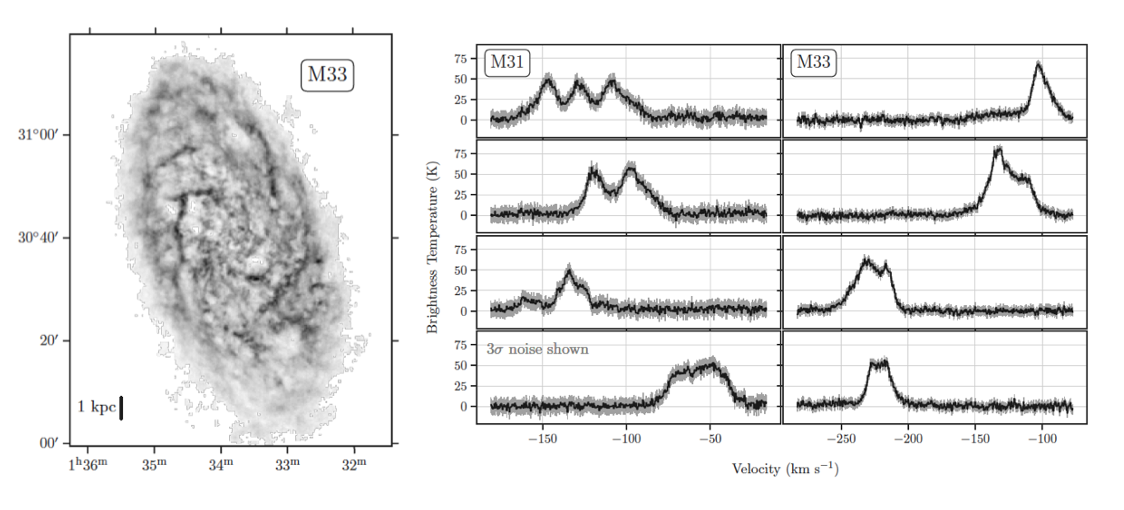
Archival data from VLA C array showing (left) line-integrated 21-cm emission from M33 and (right) spectral complexity in 21-cm spectra from individual 60-80 pc regions in M31 and M33 from Koch et al. (2021). The figure illustrates the detailed structure and kinematic complexity that will be revealed by the new Local Group X-Large survey. In the Local Group, the VLA’s unmatched physical and spectral resolution reveals individual HI clouds, HII regions, supernova remnants, and other discrete features previously only accessible in the Milky Way. The new survey will improve on these archival data by a factor of > 4 in angular resolution, extend the coverage to all six VLA-accessible Local Group star-forming galaxies, and also include continuum mapping with resolution as high as 1.5 arcsecond (< 10 pc). When complete, the survey will produce a complete, highly-resolved view of atomic gas and radio continuum across the six VLA-accessible Local Group star-forming galaxies and deliver the corresponding data products to the hands of the community.
[click to enlarge]
In 2018 NRAO solicited expressions of interest for “Extra-Large” (or “X”) observing proposals requesting more than 1,000 hours of telescope time and/or extending over four or more observing semesters, based on a recommendation from the NRAO Users Committee. The level of interest was sufficiently high that a formal request for “X-Large” projects was issued during the 2020A Call for Proposals in July 2019. After a review process by the Extra-Large Proposal Science Advisory Committee, one proposal, “A VLA Local Group Legacy Survey” (VLA/20A-346) was selected for further consideration.
This program will image the atomic gas (via the 21-cm line), synchrotron, and free-free emission (via the L-band continuum) from all six star-forming Local Group galaxies visible to the VLA: M31, M33, NGC6822, IC10, IC1613, and WLM, using roughly 1800 hours of observations over two VLA configuration cycles. By focusing on the nearest galaxies and observing in all VLA configurations, this new legacy dataset will have an unprecedented combination of depth, spatial resolution, and spectral resolution, offering a preview of the capabilities of a next generation VLA. These data will resolve the small-scale physics that governs the interplay between the interstellar medium, star formation, and stellar feedback. The team will initially use the data to address many of the most important open questions about the galactic baryon cycle: how diffuse gas is organized into cold/warm phases, how turbulence is driven, how self-gravitating clouds form, and how stellar photoionization and supernovae feedback impacts the interstellar medium.
Given the large VLA investment in this new project, NRAO staff led detailed technical and operational readiness reviews, during which Drs Eric Koch (Center for Astrophysics) and Sumit Sarbadhicary (Michigan State University) played major roles demonstrating feasibility using pilot data. The project passed its review in Spring 2021, and we are pleased to announce that observations have begun in the recent D-configuration. An example of the resolution and signal-to-noise expected from this work is shown in the Figure (adapted from Koch et al. 2021).
The project is led by Adam Leroy (Ohio State University), along with Laura Chomiuk (Michigan State University), Julianne Dalcanton (University of Washington), Erik Rosolowsky (University of Alberta), Snezana Stanimirovic (University of Wisconsin), and Fabian Walter (Max Planck Institute for Astronomy), and includes members from 21 U.S. institutions. The team plans an aggressive schedule of public releases that will include 21-cm data cubes, continuum intensity and spectral index images, and catalogs of gas clouds, HII regions, and supernova remnants. The team is also eager to coordinate with other scientific efforts on these targets. Further details about the project can be found at the team's website.
Semester 2021B Telescope Time Allocation

The NRAO has completed the Semester 2021B proposal review and time allocation process for the Very Large Array (VLA) and the Very Long Baseline Array (VLBA).
For the VLA the B-configuration will be available in the 21B semester and 136 new proposals were received by the 1 February 2021 submission deadline, including four large and twenty-five time critical (triggered) proposals. The oversubscription rate (by proposal number) was 3.1 and the proposal pressure (hours requested over hours available) was 2.4, both of which are similar to recent semesters.
For the VLBA 58 new proposals were submitted. The oversubscription rate was 2.0 and the proposal pressure was 4.6, higher than recent semesters due to more requested hours than usual.
There was some demand for the time made available on space observatories through inter-observatory agreements, and eleven proposals requesting time on HST, Swift, Chandra, or XMM-Newton (together with AUI/NRAO telescope time) were submitted.
Proposals submitted to the GBO were assessed through the same process. Sixty-one proposals for the GBT were received for the 21B Semester. The oversubscription rate is 2.9 and the proposal pressure is 1.4. For information on proposals for GBT observations see the GBO website.
The proposals were reviewed for scientific merit by nine Science Review Panels (SRPs) and for technical feasibility by NRAO staff. These reviews were completed in February – March 2021 and then considered by the Time Allocation Committee (TAC) during a remote meeting on 19-20 April 2021. The TAC – comprising the 9 SRP chairs – was charged with recommending a science program for Semester 2021B to the Observatory Director. The recommended program was reviewed and approved on 5 May 2021.
A disposition letter was sent to the Principal Investigator and Co-Investigators of each proposal on 14 May 2021 and a TAC report containing information for proposers and observers, including statistics and telescope pressure plots, was released the same day. The approved science program for the VLA and the VLBA has been posted to the NRAO science website. The authors, title, abstract, and scheduled hours for each approved proposal can be accessed from the Proposal Finder Tool.
The Student Observing Support program continues to be available for NRAO observing programs and we encourage Principal Investigators of highly ranked VLA and VLBA proposals to consider applying for support.
The NRAO welcomes community feedback on the proposal review and time allocation process. Please provide such feedback via the Proposal Review department of the NRAO Helpdesk.
Volunteers Needed to Serve on VLA, GBT & VLBA Science Review Panels

Members of NRAO’s Science Review Panels (SRP) play a very important role in identifying the Science Programs for these world-leading radio telescopes.
Being a reviewer could help you to:
- Learn what science other astronomers are interested in;
- Get a sense of what makes the most compelling proposals;
- Build your group of professional contacts and potential collaborators;
- Understand the review process for a major observatory.
If you are interested, volunteer to be an SRP member by filling out a simple form.
MPIfR Continues Support of VLBA Open Skies
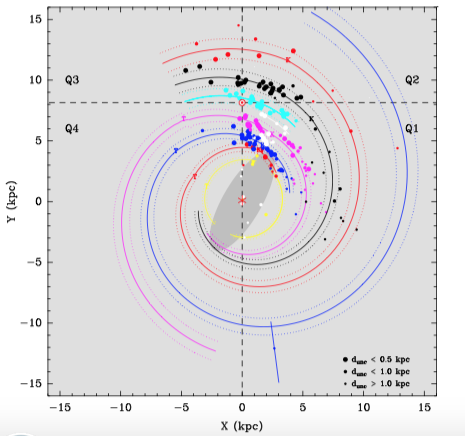
Figure 1: see caption below
[click to enlarge]
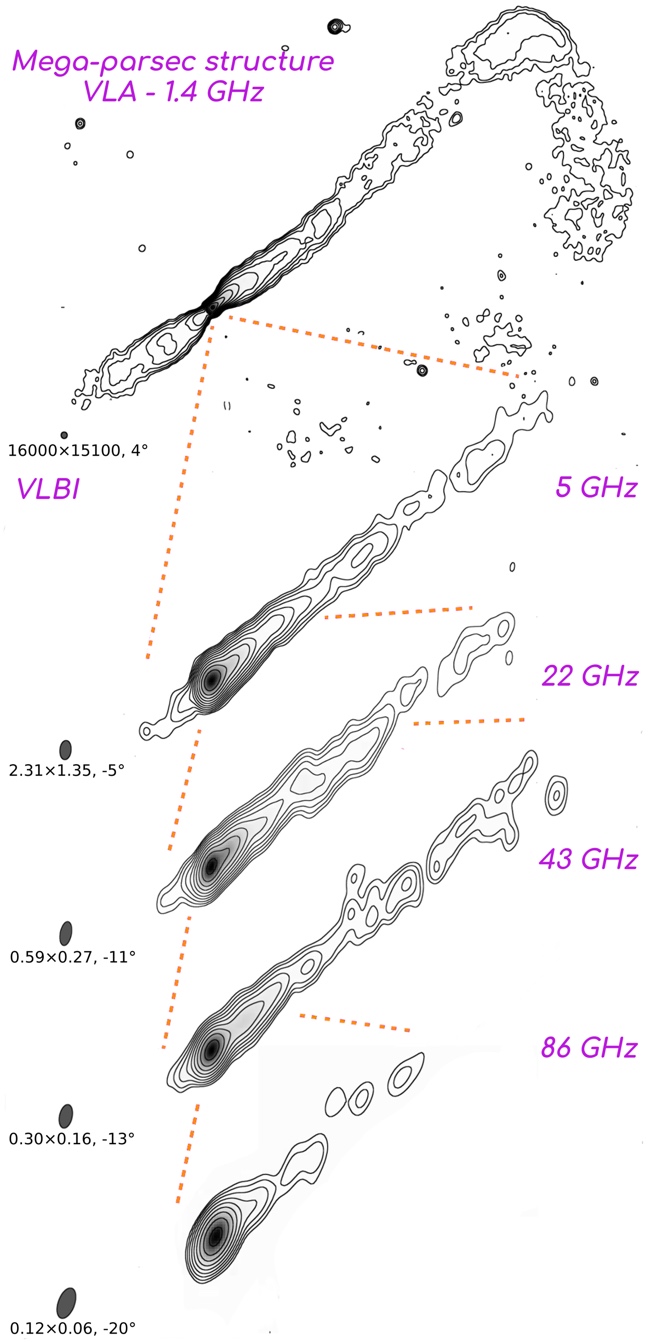
Figure 2: see caption below
[click to enlarge]
The NRAO and Max Planck Institute for Radio astronomy (MPIfR) have a long-established tradition of scientific and technical collaboration. MPIfR has contributed funding for the upgrades of the VLBA 3mm receiver system (1999) and 1cm receiver system (2007) and has contributed operating funds to the VLBA since 2012. NRAO is happy to report that the MPIfR has renewed is contribution through 2022. These contributions make a significant positive impact to Open Skies such as enabling continued VLBA participation in the Global VLBI Millimeter Array (GMVA) and generally maintaining high frequency (3mm wavelength) observing capabilities.
MPIfR has made many contributions to astronomical science through the use of the VLBA and has trained numerous students and postdocs in the process. This includes fundamental research at the highest angular resolutions through 3mm GMVA observing and exploration of the structure and kinematics of the Milky Way galaxy through ultra-high precision astrometry (see Figure 1).
The 100m Effelsberg radio telescope, operated by the MPIfR, regularly joins the VLBA in GMVA and High Sensitivity Array (HSA) observations leading to overall greater sensitivity and resolution. The high sensitivity provided by the Effelsberg collecting surface together with the dense (u,v)-coverage resulting from its combination with the VLBA allow for high-fidelity imaging of powerful AGN jets and for the detection of faint sources such as the afterglow of gravitational wave merging events. The latter was shown, e.g., in GW170817 (Ghirlanda et al. 2019). A recent example of the synergy between NRAO telescopes and Effelsberg is the multi-wavelength study of the jet collimation in the galaxy NGC 315 (see Figure 2).
References
Boccardi et al. A&A 647, A67 (2021)
Ghirlanda et al. Science 363, 968 (2019)
Reid et al. ApJ 885, 131 (2019)
Figure 1: Plan view of the Milky Way from the north Galactic pole. Locations of ~ 200 high-mass star-forming regions are shown for which trigonometric parallaxes were measured in the BeSSeL survey with the VLBA and the Japanese VERA project. MPIfR scientists are heavily involved in the BeSSeL survey (Principal Investigator: Mark Reid, Center for Astrophysics | Harvard Smithsonian). Galactic rotation is clockwise. The Galactic Center (red asterisk) is at (0,0) and the Sun (red Sun symbol) is at (0,8.15) kpc. Based on these results, four spiral arms (colored traces) could be assigned and located (Reid et al. 2019, from which the figure is adapted). Galactic quadrants are divided by gray dashed lines. The "long" Galactic bar is indicated with a shaded ellipse.
Figure 2: Jet structure of NGC 315 from mega-parsec to sub-parsec scales. The results show that jet collimation is completed at sub-parsec scales, and a transition from parabolic to conical jet shape is observed at a distance of about 5000 Schwarzschild radii, much smaller than the Bondi radius (Boccardi et al. 2021).]
ALMA Program News
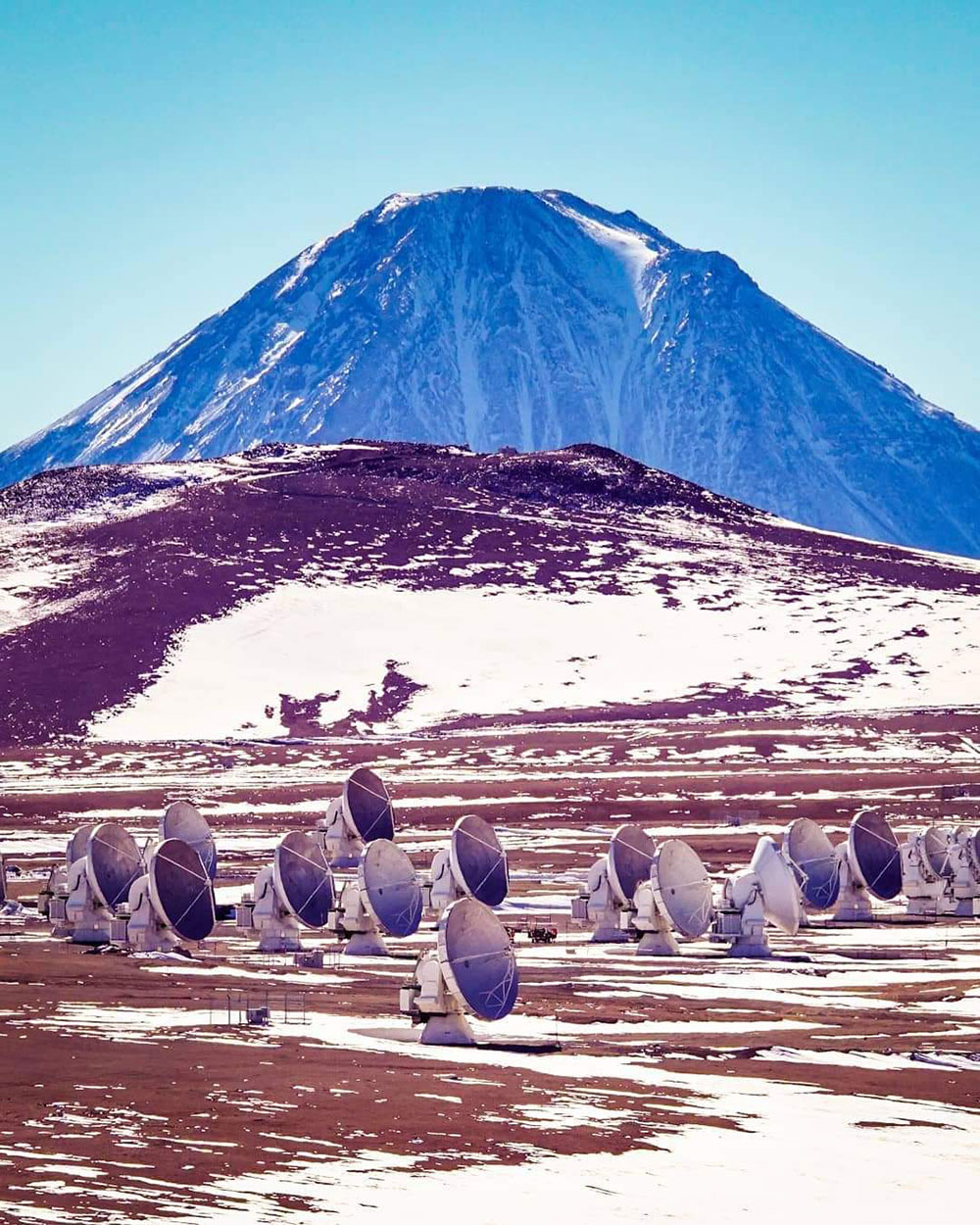
Licancabur (elevation 5916m) looms over the ALMA antennas in May 2021 as they pursue Cycle 7 observations into the approaching southern-hemisphere winter.
[click to enlarge]
Cycle 7 Observations Continue
Recently, ALMA Director Sean Dougherty noted that '”…the Return to Operations Gate Review Panel has reaffirmed its recommendation for the shift of May 29th to increase the numbers at the [Operations Support Facility] based on the external factors and the actual situation onsite. The increase in people on site will be from a maximum of 90 to 105.”
ALMA has moved to its C43-6 configuration and continues Cycle 7 PI observations with up to 50 12m antennas. The array will continue its scheduled expansion. The Atacama Compact Array has also resumed observations with at least 8 antennas.
This unprecedented challenge that ALMA, and the global community, have had to face over the past 14 months has been captured extraordinarily well in a recently premiered documentary titled ALMA: The Rebirth of a Giant. Please watch and take great pride at ALMA's success in returning to science operations.
Cycle 8 2021 Proposal Submission Statistics
A detailed report of the Cycle 8 2021 Proposal Submission Statistics is available on the ALMA science portal. The report provides a summary of items such as the number of submitted proposals and time requested, subscription rates, and comparisons with the number of hours requested in previous Cycles.
New ALMA Memo
ALMA Memo No 619 has been published by Brent Carlson, Herzberg Astronomy and Astrophysics, National Research Council Canada and is titled: A novel clock and timing approach for achieving 200+ km ALMA baselines.
Call for Proposals for ALMA Development Projects
The ALMA Development Roadmap (ALMA Memo 612), lays out the vision for keeping ALMA at the forefront of scientific discovery into the 2030s. A Call for Proposals for ALMA Development Projects in North America was released 15 Jan 2021 as part of the process to achieve the vision. An independent review panel, established with U.S. National Science Foundation (NSF) consent, has evaluated the six proposals received, as described in the previous eNews. Recommendations then receive consent from NSF and the North American ALMA Executive, who develops them further for later consideration by the ALMA Board.
ngVLA Project News
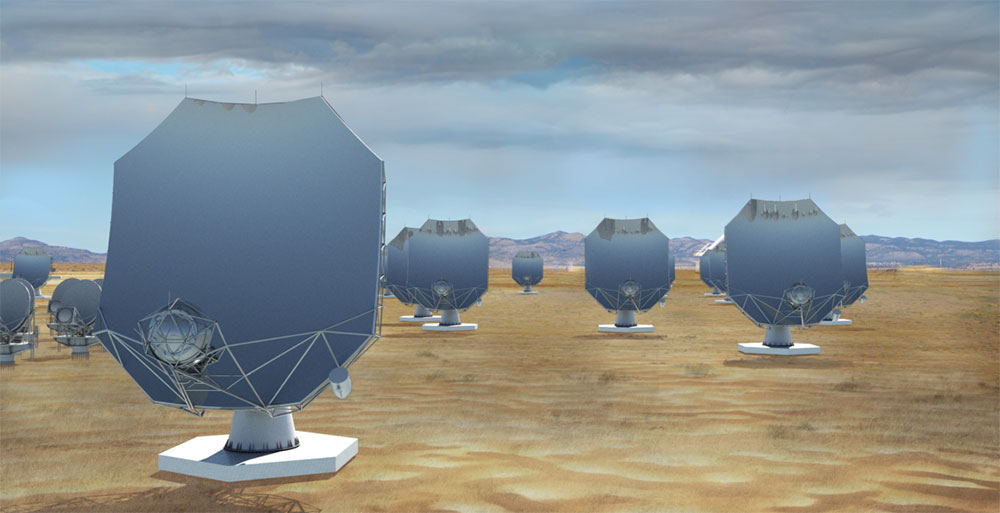
Sophia Dagnello, NRAO/AUI/NSF
Artist's conception of ngVLA antennas at the current site of the Karl G. Jansky Very Large Array on the Plains of San Agustin in west-central New Mexico.
[click to enlarge]
The NRAO has selected a contractor to develop a production-ready design and produce a prototype antenna for the Next Generation Very Large Array (ngVLA). NRAO officials signed an agreement with mtex antenna technology GmbH of Germany on 27 May.
Located in Wiesbaden, Germany, mtex antenna technology gmbh, develops and manufactures telescopes for astronomy and geodesy, as well as special antennas for demanding applications. It also supplies antenna systems and ground stations for satellites or communication with spacecraft for business, research, ministries and government agencies. The prototype will be constructed and tested in collaboration with a US partner, KTF Services, with a majority of the manufacturing activities conducted within the Southwestern US.
Under the contract, mtex will prepare a production-ready antenna design based on NRAO specifications and an earlier reference design presented in 2019 to the U.S. Decadal Survey on Astronomy and Astrophysics 2020 (Astro2020). The design will be for the 244 ngVLA dish antennas that will be 18 meters (59 feet) in diameter. An additional 19, 6-meter (20-foot) dishes, not part of this contract, are planned for the center of the system.
The work under the new contract is planned in four phases. A baseline phase starts immediately to work on the preliminary design. Later options include completing the preliminary design and building a prototype antenna that will be installed at the site of the Karl G. Jansky Very Large Array (VLA) in west-central New Mexico, where it will undergo extensive testing. A final phase will refine the design to optimize manufacture of the additional antennas. A separate contract will be awarded for the mass production.
The ngVLA project is under review by Astro2020, a committee of the U.S. National Academy of Sciences. Their report is expected soon. Following that report, the project will need approval by the National Science Foundation’s National Science Board and funding by Congress. Full construction could begin by 2025.
See the NRAO press release for additional information.Tropospheric Composition and Circulation of Uranus

Composite ALMA image showing thermal emission, or heat, from both the atmosphere and rings of Uranus. The FoV is 8 arcsec. Dark bands in the atmosphere trace molecules that absorb radio waves, notably hydrogen sulfide. Bright regions like the north polar spot, in yellow, contain very few of these molecules. Thermal emission from the rings, only recently detected, implies a frigid temperature of 77 K (-320 F). Adapted from Molter et al. (2019).
[click to enlarge]
The ice giants Uranus and Neptune are the closest solar system analog to the most abundant exoplanets, which are Neptune or sub-Neptune-sized (Thompson et al. 2018), and harbor key clues to the way planet formation proceeds in the icy outer regions of a protoplanetary disk. They also provide fascinating testbeds of atmospheric chemistry and dynamics in the low-solar-forcing regime: Neptune has a moderate inclination and strong internal heating, while Uranus is tipped on its side and displays no detectable internal heat. The atmospheres of these gas giants extend so deep that they lack a well-defined bottom, but visible and infrared images can only probe the topmost cloud layers. Atmospheric studies therefore rely heavily on radio observations with interferometers like ALMA, the VLA, and (soon) the ngVLA to peer through the clouds and understand the complex chemistry and dynamics happening below.
Using ALMA and the VLA, our team made spatial maps of Uranus’s atmosphere in eight wavelength bands from 1.3mm to 10cm (Molter et al. 2021); see the figure for a sample image. Since longer wavelengths probe deeper into the atmosphere, these images allowed us to probe the chemistry and dynamics of the atmosphere at pressures from ~1 to ~50 bar. Using radiative transfer modeling, we determined the physical origin of the brightness variations across Uranus's disk. The planet's equator and midlatitudes are radio-dark due to a high abundance of hydrogen sulfide (H2S) gas, which absorbs radio waves. By contrast, the bright north polar region is attributed to strong depletions in both H2S and ammonia (NH3) extending down to ~30 bar; these depletions mean that no gas is present to absorb the radio waves and we can see very deep, warm atmospheric layers at the planet’s pole. Our observations support the hypothesis that H2S is much more enriched than NH3, providing crucial information on planetary formation processes. An ammonium hydrosulfide (NH4SH) cloud forms from the combination of NH3 and H2S (de Pater et al. 2018) at the ~30 bar level, effectively removing most NH3 gas from the atmosphere above.
Overall, existing observations suggest a global circulation pattern in which gases are rising from the deep atmosphere (pressures >50 bar) up to the tropopause (~0.1 bar) at the radio-dark midlatitudes and subsiding at the radio-bright north pole.
The ngVLA promises to be an indispensable tool for studying planetary atmospheres like those of Uranus and Neptune. The unparalleled sensitivity will make snapshot observations possible, with integration times so short that smearing of the signal in longitude due to the planet’s rotation will no longer be a concern. We will then be able to study the way planetary waves, vortices, and storms, such as Neptune’s dark spots (Wong et al. 2018) and Uranus’s Berg storm (de Pater et al. 2011), affect the deep atmosphere. The huge wavelength coverage will also allow us to probe even deeper into the atmosphere at high spatial resolution, improving our understanding of the role of NH3 and H2S and, through mapping of the CO 1-0 line, perhaps constrain the deep water abundance in the ice giants.
Since 2015 the acronym ngVLA has appeared in 700+ publications indexed in the SAO/NASA Astrophysics Data System. This article continues a regular feature intended to highlight some of those publications. We are especially interested in showcasing work done by early-career researchers. Anyone wishing to volunteer to author a feature should contact Joan Wrobel
First Announcement: 10th IRAM 30-meter School on Millimetre Astronomy
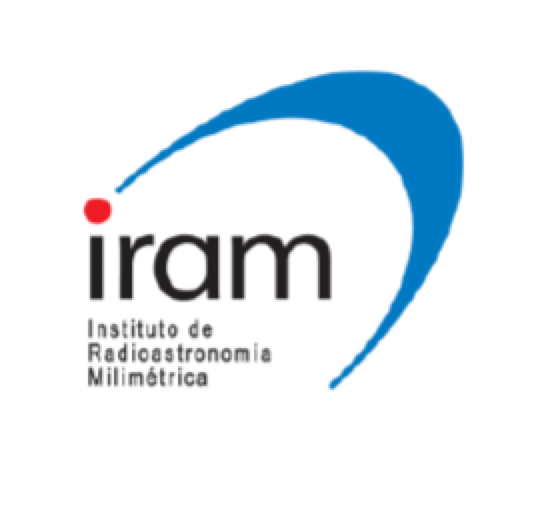
Due to the special circumstances derived from the COVID-19 pandemic, the 10th edition of the IRAM 30-meter School on Millimetre Astronomy will be held on-line, on 15-19, 22 and 23 November 2021. On-line registration will open shortly.
As in previous editions, the school will combine lectures on millimetre astronomy with observations using the 30-meter telescope. Lectures will be given by experienced scientists and 30-meter observers, covering a wide range of topics, including the study of the chemistry of interstellar clouds, low and high mass star formation, in the Milky Way, in nearby galaxies, and at high-redshifts. In addition, the school will include lectures on instrumentation, observing techniques, and data processing. This edition will highlight the synergies with the IRAM NOrthern Extended Millimetre Array (NOEMA).
The lectures will be complemented by practical work using the 30-meter telescope. As usual, students, lecturers and technical assistants will form small groups, to work on one topic, preparing a science case, conducting the observations with the 30-meter telescope, reducing the data, and presenting first results on the last day of the school. However, unlike previous schools, where trainers and students performed their observations at the telescope site, in this edition all observations will be conducted in remote mode.
The school is aimed at attracting new scientists to current and future single-dish millimetre and submillimetre facilities. The school is primarily meant for young researchers with little previous experience in mm-astronomy. Due to the constraints imposed by the practices at the telescope (even in remote mode), the school attendance will be limited to about 60 students who will be selected on the basis of their interests, experience, and references. Other considerations will be taken into account. In particular, we will strive to achieve balance in gender and geographical origin for attendees and lecturers.
The school pages will be available soon in the IRAM web site. For reference the information of the previous school edition (September 2019) can be consulted here.
Virtual VLA Tour: Juneteenth
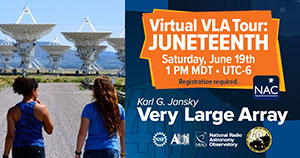
Each summer, the National Radio Astronomy Observatory (NRAO) welcomes new students to our National Astronomy Consortium (NAC), an innovative program that provides research opportunities and long-term mentoring support to underrepresented students in the STEM fields. In honor of Juneteenth, we hope you will join us for a special Very Large Array (VLA) virtual tour led and presented by this year’s NAC students, where they will talk about the cutting-edge science done by the VLA and how they are utilizing it for their research projects.
This virtual tour will take place on Saturday, 19 June 2021, 1-2 p.m. MDT [Mountain Daylight Time, UTC/GMT – 6].
This event will take place on Zoom. Registration is required.
Press Releases
Do you know the best time to alert the News Group about your paper/research? It's once you have submitted it to a journal, and even earlier if possible (but not later, please).
That is because the process of drafting a news-worthy press release includes many collaborators: multiple Public Information Officers, writers, reviewers, illustrators, image processors, and social media. The more notice we have, the more time we have to create a "stellar" press package.
- If you have an upcoming paper for VLA or VLBA send to Dave Finley.
- If you have an upcoming paper for ALMA or news about NRAO or CDL, send to Amy C. Oliver.
Not sure if your paper would make a good press release? That's what News Group is here for! We are trained to evaluate science results for public press opportunities, but we can't do that if we don't about your paper. Our doors (both in real life and virtually) are always open, so if you have questions or a paper, please reach out.
Recent Media Releases
From the Archives
Ellen Bouton

[click to enlarge]
About this month's photo: The 1999 Summer students from Socorro visit the NRAO-Kitt Peak 12m telescope. (left to right, standing) Allison Coil, Liz McGrath, Bryan Jones, Niruj Mohan, Crystal Brogan, Chad Young, Colleen Schwartz, Makenzie Lystrup, Hannah Smith; (sitting) Darrell Osgood, and Teddy Cheung at the 12-meter NRAO telescope. The photo was taken by one of the participants or mentors of the 1999 REU program, but we are uncertain who was holding the camera.
For over six decades, NRAO has welcomed summer students to our sites to work on a wide variety of research projects with NRAO staff mentors. As in summer 2020, the summer program in 2021 will be conducted remotely because of COVID-19 protocols. Our incoming class of 55 students will participate in a rich and unique research and professional development experience. The program kicks off with the Radio Astronomy Bootcamp, a week-long workshop with lectures and hands-on observing. Students will then work remotely on their research under the supervision of their mentors. Since its inception in 1959, the summer student program has engaged over 1,300 young people in scientific research, and many NRAO summer students have gone on to distinguished careers in astronomy and other physical sciences.
From the Archives is an ongoing series illustrating NRAO and U.S. radio astronomy history via images selected from our collections of individuals' and institutional papers. If readers have images they believe would be of interest to the Archives, please contact Ellen Bouton.

